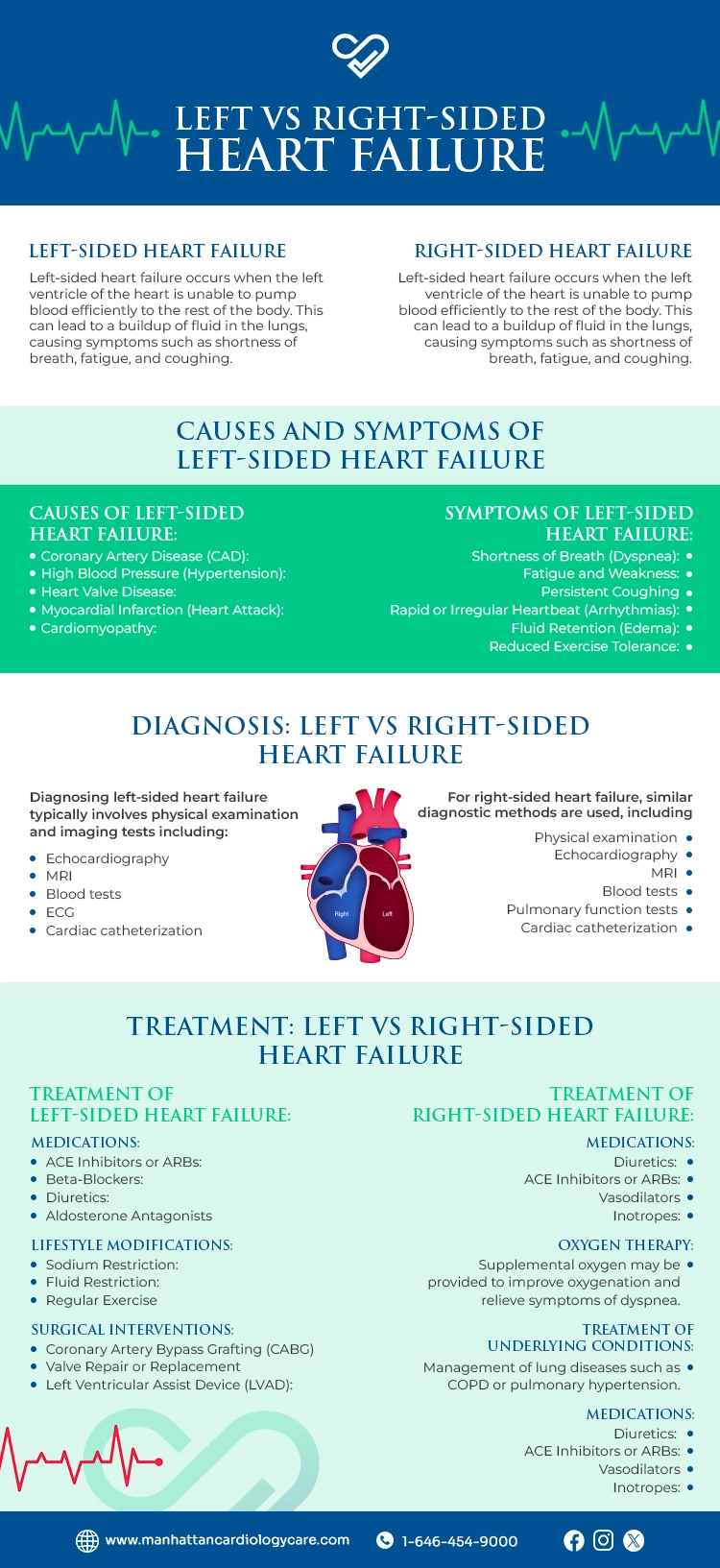Table of contents
Left-Sided Heart Failure
Left-sided heart failure occurs when the left ventricle of the heart is unable to pump blood efficiently to the rest of the body. This can lead to a buildup of fluid in the lungs, causing symptoms such as shortness of breath, fatigue, and coughing.
Right-Sided Heart Failure
Right-sided heart failure involves the right ventricle failing to pump blood effectively to the lungs for oxygenation. This results in fluid retention in the body’s extremities, leading to symptoms like swelling in the legs and abdomen, fatigue, and decreased appetite.
Difference Between Left and Right-Sided Heart Failure
Left-sided heart failure primarily affects the left ventricle, leading to symptoms like shortness of breath and fatigue due to insufficient circulation to the body.
In contrast, right-sided heart failure involves the right ventricle’s inability to pump blood effectively to the lungs, resulting in symptoms such as swelling in the legs and abdomen.
Causes and Symptoms of Left-Sided Heart Failure
Causes of Left-Sided Heart Failure:
- Coronary Artery Disease (CAD): Blockages in coronary arteries reduce blood flow to the heart.
- High Blood Pressure (Hypertension): Chronic high blood pressure thickens the left ventricle.
- Heart Valve Disease: Impaired heart valves increase pressure on the left ventricle.
- Myocardial Infarction (Heart Attack): Blockage of heart blood flow damages heart tissue.
- Cardiomyopathy: Heart muscle disorders affects structure and function.
Symptoms of Left-Sided Heart Failure:
- Shortness of Breath (Dyspnea): Difficulty breathing, especially during activity.
- Fatigue and Weakness: Reduced energy due to inadequate oxygen delivery.
- Persistent Coughing: Chronic cough, sometimes with pink sputum.
- Rapid or Irregular Heartbeat (Arrhythmias): Abnormal heart rhythms.
- Fluid Retention (Edema): Swelling in legs, ankles, or abdomen.
- Reduced Exercise Tolerance: Difficulty with physical activity due to symptoms.
Causes and Symptoms of Right-Sided Heart Failure
Causes of Right-Sided Heart Failure:
- Left-Sided Heart Failure: Can strain the right ventricle due to increased pulmonary pressure.
- Lung Diseases: Conditions like COPD or pulmonary hypertension stress the right heart.
- Cor Pulmonale: Results from chronic lung disease, causing right heart pressure.
- Heart Valve Disease: Impairs blood flow, affecting the right heart chambers.
- Congenital Heart Defects: Birth defects disrupting normal heart function.
Symptoms of Right-Sided Heart Failure:
- Peripheral Edema: Swelling in legs, ankles, or abdomen due to fluid retention.
- Ascites: Abdominal fluid buildup causing distension and discomfort.
- Jugular Vein Distention: Visible neck vein swelling indicates increased heart pressure.
- Fatigue and Weakness: Decreased energy due to poor circulation.
- Shortness of Breath (Dyspnea): Breathing difficulty, especially during exertion or lying flat.
- Liver Congestion: Hepatic symptoms like abdominal pain, tenderness, and elevated enzymes.
Diagnosis: Left vs Right-Sided Heart Failure
Diagnosing left-sided heart failure typically involves physical examination and imaging tests including:
- Echocardiography
- MRI
- Blood tests
- ECG
- Cardiac catheterization
For right-sided heart failure, similar diagnostic methods are used, including:
- Physical examination
- Echocardiography
- MRI
- Blood tests
- Pulmonary function tests
- Cardiac catheterization
Treatment: Left vs Right-Sided Heart Failure
Treatment of Left-Sided Heart Failure:
1) Medications:
- ACE Inhibitors or ARBs: to reduce blood pressure and improve heart function.
- Beta-Blockers: to decrease heart rate and workload on the heart.
- Diuretics: to reduce fluid buildup and relieve symptoms of congestion.
- Aldosterone Antagonists: to reduce fluid retention and improve heart function.
2) Lifestyle Modifications:
- Sodium Restriction: to reduce fluid retention.
- Fluid Restriction: to prevent fluid overload.
- Regular Exercise: under supervision to improve heart function and overall health.
3) Surgical Interventions:
- Coronary Artery Bypass Grafting (CABG): to improve blood flow to the heart muscle.
- Valve Repair or Replacement: to correct valve abnormalities.
- Left Ventricular Assist Device (LVAD): to support heart function in severe cases.
Treatment of Right-Sided Heart Failure:
1) Medications:
- Diuretics: to reduce fluid buildup and relieve symptoms of edema.
- ACE Inhibitors or ARBs: to reduce blood pressure and improve heart function.
- Vasodilators: to dilate blood vessels and reduce pulmonary artery pressure.
- Inotropes: to improve heart contractility in severe cases.
2) Oxygen Therapy:
- Supplemental oxygen may be provided to improve oxygenation and relieve symptoms of dyspnea.
3) Treatment of Underlying Conditions:
- Management of lung diseases such as COPD or pulmonary hypertension.
- Addressing conditions contributing to right-sided heart failure, such as left-sided heart failure or heart valve disease.
4) Surgical Options:
- Valve Repair or Replacement: to correct valve abnormalities affecting right heart function.
- Pulmonary Thromboendarterectomy: to remove blood clots in cases of chronic thromboembolic pulmonary hypertension.
- Lung Transplantation: for severe cases of pulmonary disease causing right-sided heart failure.
When To See a Doctor?
If you experience symptoms such as shortness of breath, fatigue, swelling, or rapid heartbeat, it’s essential to seek medical attention promptly. These could be signs of heart failure or other serious health conditions that require evaluation and treatment.
– Disclaimer –
This blog is for informational & educational purposes only, and does not intend to substitute any professional medical advice or consultation. For any health related concerns, please consult with your physician, or call 911.


